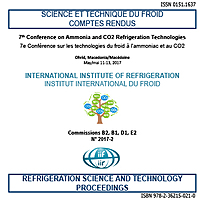
Document IIF
Systèmes de congélation adaptés à des températures ambiantes élevées.
Freezing systems for high ambient temperatures.
Numéro : pap. n. 0017
Auteurs : PACHAI A. C.
Résumé
In the discussions about phase down of some types of refrigerants, the topic of what to do in areas with high ambient temperatures has caused some concerns. The definition of high ambient temperatures was a little undefined in the beginning, but this has now been clarified at the meeting in Kigali, 14. Oct 20161. CO2 trans-critical systems have gained a lot of interest especially in the mild and moderate warm countries. Comparisons have shown that these systems can be more efficient than an R404A solution for these climates. Cascade in warm and high ambient temperature countries can be even better. One way to reduce the condensing temperature is by using evaporative systems. It can be either cooling towers or evaporative condensers. A newer method is adiabatic cooling systems where you evaporate some water at the dry-cooler inlet in the warm period of the year. For some climates, this will require regular cleaning of the coil in order to avoid dust to produce a layer on the surface of the heat exchanger that can stop the airflow. When it is about food processing and freezing and for high ambient temperature regions the cascade solution is a competitive solution when you want to freeze different kinds of food especially meat, bread, cakes, fish, fruits, vegetables etc. In many warm countries, different ways of cooling the condenser can be used. This paper will discuss what can be a road block for using the most efficient solution. Is it the price of water and electricity or is it the technology that does not perform under these conditions? The typical cold store does not need a lot of heat, so we cannot assume this will be of any interest. Does the cascade system require skills, which the normal technician does not have already? It is very different what skills the average technicians have all over the world. It is therefore of great interest when ISO has now started the process of implementing EN 13313 in the ISO standards. This will increase the level of knowledge and as a positive result the safety will benefit. About 60% of accidents involving air conditioning and refrigeration systems happen during service and maintenance. If we look at other statistics, we will see most accidents are related to valves and flanges2. Many accidents are also related to lack of proper welding and placing of the piping. This can mostly be related to lack of knowledge or training. It supports the requirements for better training and with standardised requirements for knowledge it is up to the education institutions to fill in the knowledge so the students can get the required level of competence.
Documents disponibles
Format PDF
Pages : 8
Disponible
Prix public
20 €
Prix membre*
Gratuit
* meilleur tarif applicable selon le type d'adhésion (voir le détail des avantages des adhésions individuelles et collectives)
Détails
- Titre original : Freezing systems for high ambient temperatures.
- Identifiant de la fiche : 30021636
- Langues : Anglais
- Source : 7th Conference on Ammonia and CO2 Refrigeration Technology. Proceedings: Ohrid, North Macedonia, May 11-13, 2017.
- Date d'édition : 11/05/2017
- DOI : http://dx.doi.org/10.18462/iir.nh3-co2.2017.0017
- Document disponible en consultation à la bibliothèque du siège de l'IIF uniquement.
Liens
Voir d'autres communications du même compte rendu (42)
Voir le compte rendu de la conférence
Indexation
-
DESIGN FOR MINIMUM REFRIGERANT CHARGE.
- Auteurs : JAMES R. W.
- Date : 11/1989
- Langues : Anglais
Voir la fiche
-
Ammonia refrigerating systems of new generation...
- Auteurs : CHUMAK I. G., CHEPURNENKO V. P., TERZIEV G. S., ONISCHENKO V. P.
- Date : 10/05/1994
- Langues : Anglais
- Source : New Applications of Natural Working Fluids in Refrigeration and Air Conditioning
- Formats : PDF
Voir la fiche
-
Mélanges binaires pour un cycle en cascade inté...
- Auteurs : DEWITTE P., CLODIC D.
- Date : 07/09/1992
- Langues : Français
- Source : Proposals for the generation and use of refrigeration in the 21st century.
- Formats : PDF
Voir la fiche
-
The status of industrial refrigerating systems ...
- Auteurs : BADGER B.
- Date : 07/09/2008
- Langues : Anglais
- Source : 8th IIR-Gustav Lorentzen Conference on Natural Working Fluids (GL2008)
- Formats : PDF
Voir la fiche
-
Advanced absorption technology for energy savin...
- Auteurs : ALEFELD G., et al.
- Date : 29/08/1990
- Langues : Anglais
- Source : Heat pumps and energy recovery.
- Formats : PDF
Voir la fiche
